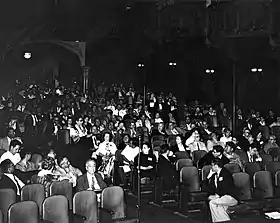Willard LaMere
Willard LaMere (1918 – November 29, 1990) was a Native American community organizer and educational leader in Chicago, Illinois in the mid twentieth century, a period when the US government's Indian termination policy encouraged Native Americans to assimilate into mainstream American society.[1] Working to preserve Native American culture and values as Native Americans moved from reservations to cities, LaMere was instrumental in founding, among other organizations, the Native American Educational Services College, which became the first higher education institution in an urban setting managed by and serving Native Americans.[2] He was also the college's first graduate.[3]
Willard LaMere | |
|---|---|
| Born | July 1, 1918 |
| Died | November 29, 1990 (aged 72) Oneida, Wisconsin, U.S. |
| Nationality | Ho-Chunk |
| Spouse(s) | Rosalie |
American Indian Center (AIC)
A member of the Ho-Chunk nation, LaMere moved to Chicago in 1937 and became well-respected leader in Chicago's American Indian community.[2] In the early 1950s, Kurt Dreifus of the Bureau of Indian Affairs (BIA) in Chicago convened a meeting of concerned “businessmen, university professors, welfare agency officers, clergymen, etc.” as a Citizens Advisory Board to the BIA. The board’s mission was to study the needs of the growing and diverse Native American populations in the city of Chicago. LaMere, who was executive director of the Chicago branch of the Quaker-affiliated American Friends Service Committee (AFSC), attended and became "particularly instrumental" in the creation of a new service organization. Patterning their effort on a similar center opened in Los Angeles by AFSC, Willard took the lead in fundraising. The American Indian Center (AIC) opened at the corner of La Salle and Kinzie streets in September 1953. The Center provided a variety of activities including social gatherings every Saturday, holiday meals, periodic pow-wows, and a dance club that performed around the region. The Center also organized Native American participation in Chicago parades and other city events.[4] Today, the AIC remains the primary cultural and community resource for the more than 65,000 Native Americans in the greater Chicago area.[5]
American Indian Chicago Conference (AICC)

LaMere was among the lead organizers of the influential 1961 American Indian Chicago Conference (AICC).[6] He helped bring together 460 American Indians from 90 tribes from June 13 to June 20, 1961. A second convener of the event, University of Chicago anthropologist Sol Tax, the founder of "action anthropology," described the purpose of the event as helping "all Indians of the whole nation to express their own views" and to create if possible a shared "Declaration of Indian Purpose."[7] Representatives from the conference formally presented the declaration to President John F. Kennedy in a ceremony at the White House in 1962. The spirit of self-determination expressed in the document was a cornerstone of Native activism in the years that followed, including the Red Power movement and the expansion of Native American gaming.[8]
Other
In 1979, LaMere founded Chicago's American Indian Business Association of the Midwest. Chicago's Indian Council Fire organization honored LaMere with this 1988 Indian Achievement of the Year Award.[2]
References
- Getches, David H.; Wilkinson, Charles F.; Williams, Robert L. (2005). Cases and Materials on Federal Indian Law. St. Paul, MN: Thomson/West. pp. 199–216. ISBN 978-0-314-14422-5.
- "Obituary: Willard LaMere, 72; developed American Indian programs". Chicago Tribune (4 December 1990). Tribune Publishing Company, LLC. Retrieved 17 October 2020.
- "NAES College: History". NAES.info. American Indian Association of Illinois. Retrieved 23 October 2020.
- Janusz, Mucha (1983). "From Prairie to the City: Transformation of Chicago's American Indian Community.". Urban Anthropology. 12 (3/4): 337–371. JSTOR 40553015. Retrieved 28 October 2020.
- "AIC History". AICChicago.org. American Indian Center. Retrieved 28 October 2020.
- Laukaitis, John J. (2009). "American Indian organizational education in Chicago: the Community Board Training Project, 1979-1989". American Educational History Journal. 36 (Issue 1-2): 445+. Retrieved 17 October 2020.
- Lurie, Nancy Oestreich (December 1961). "The Voice of the American Indian: Report on the American Indian Chicago Conference" (PDF). Current Anthropology. 2 (5): 478–500. doi:10.1086/200229. JSTOR 2739788. S2CID 143508407. Retrieved 17 October 2020.
- Niermann, Thomas A. (July 2006). The American Indian Chicago Conference, 1961: A Native response to government policy and the birth of Indian self-determination (PhD). Dept. of History, University of Kansas. Retrieved 29 October 2020.